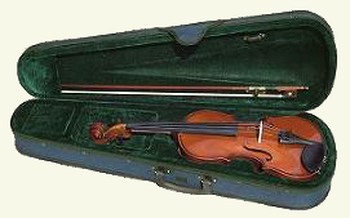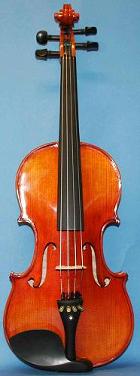
What is it that makes one violin better than another ?
Like most purchases in this world, the more you pay the better the product you get. Violins are no exception to this rule and it is particularly noticeable with the lower priced student violins. A few tens of pounds extra can make a big difference.
A good quality violin is made of particular woods based on years of experience by thousands of Luthiers throughout the world. It's generally recognised that the best material for the front or table of a violin is close grained Spruce. The back, neck and sides (ribs) are made of Maple. The Fingerboard, Pegs and End Button are made of one of the hardest woods, Ebony. The wood should also be dry and well seasoned. 12 years is good 30 years is better.
Ebony's hardness and strength makes it ideal for fingerboards and pegs. It retains it's shape and is not affected as much as other woods by moisture in the atmosphere. Because of its hardness it wears well and pegs made of Ebony can be finely shaped and once fitted will stay true for many years.
It's generally accepted that the best and most expensive instruments are made in Italy, France & Germany. Unfortunately they are usually much too expensive for most students and the vast majority of young people start with an instrument made in China. The Chinese have been making musical instruments for centuries and have some excellent craftsmen. Many of the better Chinese workshops are run by Luthiers (violin makers) who have spent several years apprenticed to a European maker and as a result the quality of their work is superior. It's interesting to note that the Chinese Luthiers have dominated the international violin making competitions since 2004. In 2006 the Gold Medal of The Violin Society of America awards was won by Zhu Ming-Jiang from Bejing. Latterly Violin makers in Romania have made quite a name for themselves. Gliga in particular feature very highly in the satisfaction stakes and you will find many glowing reviews on the web forums.
The cheapest violin outfits, priced up to about £80 are made of inferior woods, often barely seasoned and they are mostly machine made. In particular the finger board and pegs are made of a hardwood, which has been dyed black or ebonised. This hard wood is not as durable as ebony and as a result it is much more difficult to fit the pegs, The softer wood wears more quickly and often swells or shrinks as the moisture in the atmosphere changes. Some days the pegs will stick on other days they will slip.
Some of the really cheap violins don't even have carved plates. The makers use thin sheets of wood and mould them using steam and high temperatures in an autoclave. Needless to say there is limited control of the plate thickneses and the plates can over time, loose their shape.

Because these violins are made as cheaply as possible they are often fitted with the cheapest strings and their set up is at best, rudimentary. When you consider what you get for £80 or less, a violin, a bow, a case and rosin you really cannot expect that much from the violin. We tried selling these in our early years but despite a considerable amount of effort on the bench the end result was seldom satisfactory. I suppose you really can't make a silk purse from a sow's ear. We decide to cut our losses a few years ago and don't offer them for sale now. Even our cheapest instruments have Ebony fittings.


As the violin gets more expensive, the quality of its manufacture improves. Violins in the £100 to £300 range will have Ebony parts, it may not be the best Ebony but it will be better than the cheap hardwood used in starter outfits. Similarly the bow will be made of better quality wood, the fittings will be more accurately made and the bow better balanced. At the top end of this range you can expect to get much better strings. At the Violin Company we usually fit synthetic cored Correlli Crystal or Thomastik Dominant strings to our violins in this price range.
Once you get above the £300 mark then you are looking at a much more professionally made instrument. The woods used to make the violin will be better seasoned and more care will have been taken during the manufacture. Most of the violin will be hand made and a Luthier will adjust the top and bottom plates for their acoustic quality as well as just following a set of patterns. The set up will be more meticulous and the violin will be easier to play as a result. Obviously all this care and attention takes much more time and this is what you are paying for.
Having said all that what should you buy for your budding Pagannini?. The simplest answer is pay as much as you can afford but consider the following:- Smaller size violins 1/4, 1/2, 3/4 will rarely sound as good as a full size violin for all sorts of reasons. Most students only keep them for a couple of years before moving on to the next size. So it seems reasonable to assume that you shouldn't pay too much for a small size violin.. In many respects this is true but you should also be aware that a better quality instrument is normally easier to play and your child will make better progress. So we recommend that you should at least consider something a little better than the basic (cheapest) instrument..
One way of overcoming the problem of the short term ownership of small size violins is to rent a violin for the 1/4, 1/2 and maybe 3/4 sizes and buy a full size one when the student moves to that. We offer some of our violins for monthly rental. See our terms and conditions here.....
The better quality instruments do have a higher resale value too, in the same way that a better specification elevates the price of a secondhand car.
When it comes to full size instruments once a student gets above grade 3 then they really should have a better quality instrument, be it new or secondhand.